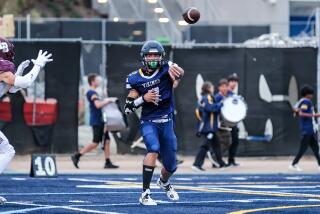Transfer Requests Soaring
- Share via
Legislation designed to curb an ever-growing swell of athletes seeking to change high schools has instead prompted a record number of transfer requests.
The California Interscholastic Federation Southern Section, the governing body for sports programs at 529 high schools in Southern California, has received 7,331 athletic transfer requests for next fall. That’s an average of nearly 14 per school, an indication that many families are engaged in a mad dash to beat the transfer clock.
A rule that will be implemented in the fall of 2003 requires athletes to sit out the next year of varsity competition if they transfer without moving.
“I would say there was a last-ditch effort to get kids in and make them eligible,” Downey High Principal Allen Layne said.
Students had until May 15 to declare their intention to transfer in order to have athletic eligibility under the current open enrollment policy. Not that many will actually transfer, Southern Section officials said, because some schools reported transfer students who don’t play sports in order to protect their eligibility should they decide to go out for a team. Also, some students applied to more than one school.
Still, the number is shocking. In comparison, it is nearly double the 3,800 athletes who transferred within the section from the fall of 1999 until the first of this year.
“I think it’s a good thing,” said Gary Murphy, retiring principal at West Hills Chaminade and a leading proponent of transfer restrictions. “The message is out and people realize things are going to change. It’s a surprisingly high number, but I expected people to get in before the ax falls. It means people understand the winds are changing.”
Brandi Kimble, an all-section forward for the Newhall Hart girls’ basketball team, is among the athletes who plan to switch schools. The junior-to-be appears headed for Lynwood, the reigning state girls’ basketball champion, even though she will continue living in Stevenson Ranch near Newhall--a 43-mile commute to her new school.
Kimble’s father, Bobby, said he probably would move his family if the new rule were in place and his daughter would be forced to sit out a year. He said Brandi got to know Lynwood players through club competitions and she wants to test herself against the best teams and players.
“I don’t like [the rule], but I can understand it,” Bobby Kimble said. “Some of the transfers have to do with athletics, but others are looking to go to schools for different reasons.”
The Southern Section will be first among the state’s 10 sections to impose transfer restrictions, reversing a philosophy of encouraging student choice that went into effect shortly after the state Legislature passed the open enrollment law in 1994. Open enrollment gives parents the option to choose schools outside their neighborhood for academic reasons, but administrators and coaches say that flexibility has been used by thousands to change sports programs.
When revisions on transfer policies were voted on in April, only 11 league representatives out of more than 70 that comprise the Southern Section council voted against the changes. The overwhelming endorsement for transfer restrictions represents concerns that the open enrollment process was being abused and threatened the stability of high school sports.
A remaining challenge is to find a balance between a parent’s right of school choice and the goal of trying to preserve competitiveness in high school athletics.
“I think in California, there’s a significant movement toward giving parents choice with the rise in charter schools, alternative schools and home schools,” said Clark Stephens, outgoing president of the Southern Section council and principal at Huntington Beach Liberty Christian. “It’s obvious parents want a choice where to send their kids. CIF is wrestling with that and how it impacts high school athletics.”
Peter Suarez, a 6-foot-3, 245-pound tight end, chose to transfer from La Puente Bassett to Hacienda Heights Los Altos last December. He said he would not have made the transfer if he were forced to sit out his senior season.
“[Kids] should have a free choice no matter where you live for education or sports reasons,” Suarez said. “I don’t think restrictions should be included.”
Suarez said he is an example of someone who has benefited from transferring schools.
“It’s been real good,” he said. “My grades picked up and the football team is great.”
Suarez simply filled out a form and switched schools. Soon, it won’t be that easy. Athletes will either have to move to gain immediate athletic eligibility or spend a season on junior varsity.
Basketball transfers, in particular, have provoked the wrath of athletic administrators because of the constant movement of players to top programs, creating virtual all-star teams. It’s become almost routine for a section champion to have at least one transfer on its roster.
This year’s City Section and state champion in boys’ basketball, Westchester, had three transfers and none of its 12 players lived in the school’s attendance boundaries.
Other sections in the state have expressed similar frustrations. In the Central Section, the Selma High boys’ basketball team decided to forfeit two league games against San Joaquin Memorial because it believed that school broke transfer rules in admitting two star players.
Also, the Clovis Unified School District voted to make foreign-exchange students who transfer into the district ineligible to compete at the varsity level for one year, an action taken after Clovis West had to forfeit 70 boys’ basketball victories in 1998-99 and 1999-2000 for using a player from the Dominican Republic who was found to be 19--too old to compete in high school sports--as a sophomore.
The City Section has scheduled a vote for next March to decide whether to follow the Southern Section’s lead with its own transfer restrictions. City Section Commissioner Barbara Fiege said the Southern Section transfer figure is “a good indication of the scope of the problem” in high school sports.
“It’s the same things we’ve been dealing with,” Fiege said. “There have been significant numbers of transfers and all the issues that go with it, such as local students being displaced, the perception of the creation of all-star teams, students changing schools after beginning in one, the concept of loyalty, the opportunities for adult inducements.”
More to Read
Get our high school sports newsletter
Prep Rally is devoted to the SoCal high school sports experience, bringing you scores, stories and a behind-the-scenes look at what makes prep sports so popular.
You may occasionally receive promotional content from the Los Angeles Times.







